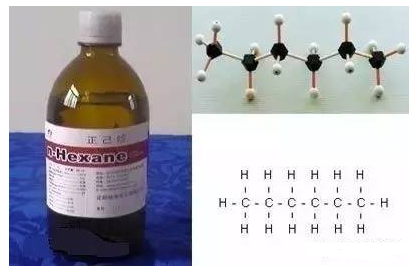What is the difference between hexane and n-hexane?
Hexane, with the molecular formula C6H14, is an alkane containing 6 carbon atoms, including n-hexane, 2-methylpentane, 3-methylpentane, 2,3-dimethylbutane and 2,2- There are five isomers of dimethylbutane. Among them, n-hexane can be used as a good organic solvent and is widely used in chemical organic synthesis, vegetable oil leaching, surface cleaning and decontamination of mechanical equipment, etc. At room temperature, hexane is liquid.
Hexane is also called n-hexane. The former is a systematic nomenclature, and the latter is a customary nomenclature. So hexane is n-hexane.
So, what the hell is n-hexane?
First, let’s give a scientific explanation: n-hexane is a slightly odorous liquid under normal conditions and is easily volatile at room temperature. It mainly enters the human body through the respiratory tract and can also be absorbed through the gastrointestinal tract.

N-hexane is also an important industrial organic solvent and is commonly used as:
1. Cleaning and decontamination agent, used for cleaning and decontamination of color printing machines and hardware and electronic components;
2. Degreasing and vegetable oil extraction;
3. Viscose preparation for shoe and ball making;
4. Paint thinner;
Many gasolines also contain n-hexane.
In addition, n-hexane is also used in catalytic reforming in the petroleum processing industry, propylene solvent recovery in the plastics manufacturing industry, and in various industries such as pharmaceuticals, furniture manufacturing, and electrical appliance manufacturing.
However, the seemingly insignificant n-hexane can cause serious harm to the human body and cannot be underestimated!
Chronic n-hexane poisoning is mainly characterized by multiple peripheral neuropathy. The incubation period is usually 10 months, and the higher the level of exposure, the shorter the incubation period. Later, prodromal symptoms such as loss of appetite, dizziness, headache, and weight loss appeared, followed by sensory abnormalities (“electric shock-like”, “ant-shaped” and “swollen and thickened” sensations in the hands and feet) and sensory disorders (finger and toe sensations). Multiple peripheral neuropathies such as distal numbness, decreased pain, touch, vibration and position sense, especially in the lower limbs, especially with muscle pain and decreased Achilles tendon reflexes), movement disorders (distal weakness of the lower limbs, muscle spasm, and then weakened tendon reflexes) and symptoms and signs of autonomic nervous system dysfunction (hyperhidrosis of hands and feet, cold peripheral skin).
Inhalation of high concentrations of n-hexane will cause eye and respiratory tract irritation symptoms, including nausea, headache, throat irritation, dizziness, etc., accompanied by fatigue, chest tightness, central nervous system anesthesia symptoms, and even unconsciousness. In severe cases, Chemical pneumonitis and pulmonary edema can occur. Oral administration may cause gastrointestinal irritation symptoms such as nausea and vomiting, as well as respiratory tract irritation symptoms. Ingestion of 50 grams can be fatal!

 微信扫一扫打赏
微信扫一扫打赏

